The Russia Rifle

By Jon R. SundraDeciding on a new life – choosing the model, caliber, scope, mount, and so on – is an exquisite agony and one of life’s great joy. Being able to specify certain aspects of a guns specs as one would with a barreled action and stock is better yet. And when its done with a specific hunt in mind, well it just doesn’t get any better than that.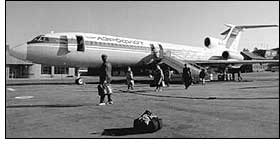
The seed for my latest project germinated when USRAC introduced the all-stainless version of the Classic Model 7- in 1994. At that time my pet rifle was the stainless steel Ruger 77-RP.
Ruger had a custom 24″ barrel re-chambered to 7mm JRS and stocked with an all-black wood laminate from Reinhart Fajen. For the final touches I slicked up the section and trigger, and glassed the barreled action in my usual manner by beddng the full length of the receiver and the first 5″ of barrel to the point where the chamber begins its straight taper to the muzzle. Topped with a 6×42 Leupold scope in Ruger rings, it made for a handsome, fine-shooting rifle.
“As new hunting areas open behind the fallen Iron Curtain, a hunter needs a rifle specifically designed for Russia’s unique game.” -Jon R. Sundra
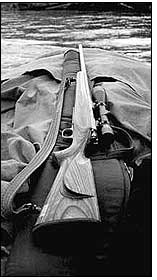 The only aspects I was not totally content with were the fact that it was the traditional Mark II – the one that Ruger made for a couple of years between 1991 and 1994 which had the static ejector, new trigger and three-position safety, but not the modified bolt face that conferred the Mauser-type controlled -round feeling function that all Ruger 77 Mark II have today.
The only aspects I was not totally content with were the fact that it was the traditional Mark II – the one that Ruger made for a couple of years between 1991 and 1994 which had the static ejector, new trigger and three-position safety, but not the modified bolt face that conferred the Mauser-type controlled -round feeling function that all Ruger 77 Mark II have today.
The other thing that bothered me was that the standard length Ruger action was a tad too short to get maximum velocity from the 7mm JRS. Bullets over 145 grains had to be seated below the base of the neck to work through the 3.4:” magazine. When I originally set down the specs for the 7mm JRS. I specified that the throat be cut for a 1/16″ leade with a 150 gr. Nosler Partition bullet seated flush with the base of the neck.
Above, a custom Model 70 chambered in 7mm JRS was Jon’s choice for hunting Siberia. He was surprised by dense brush and heavy cover rather than the open tundra he expected. Jon knew a custom Russia rifle would have to be able to withstand extreme weather conditions and primitive facilities. He chose a Black Star bore treatment for maximum accuracy and minimal maintenance.
On the new Model 70 Classic, all the features I wanted were there. The only problem was that, like Ruger, USRAC did not catalog the .280 Rern, chambering in the Classic Stainless model. I could, of coarse, have purchased one in , say, .270 or .30-06, and had it rebarreled to 7 mm JRS, but that would have added as much as $400 dollars to the project.
I contacted Bruno Pardee of USRAC’s Custom Shop and asked if there was an chance of m ordering a Model 70 Classic Stainless in.280 Rem. I mean, it seemed to me that, since they were already chambering for the .280 in the blued steel Model 70 Classic Featherweight, and offering 24″ stainless barrels in 7mm Rem. Mag. In the Model 70 Classic Stainless, what I wanted wouldn’t be that big a deal for the Custom Shop. I did specify, however, that I didn’t want it if it was something no one else could have done. “No problem.” Said Pardee, and the wheels were set in motion.
Re-Opening Siberia
All the time all these machinations were going on in the spring of ’95, I had a specific hunt in mind on which I wanted to field test the rifle. Paul Merzig of Adventure Safaris, a hunt-booking/travel agency in Chicago, and Russian Hunting, LLC in St. Petersburg were exploring the idea of opening a new area in southern Siberia for Maral stag, ibex, roebuck and musk deer.
It took a couple of months but at long last my Model 70 Stainless .280 Rem. Arrived wearing a 24″ barrel and the black, injection-molded stock that comes standard with this model. Without ever firing a shot I sent the barreled action to E.R. Shaw in Pittsburgh for the rechambering job.
Upon receiving the rechambered barreled action from Shaw, I immediately re-packaged it (again without firing a shot), and sent it to the Black Star folks in Houston to have their proprietary process applied to the bore. About a year before I sent three barreled actions to Black Star to see if their claims for increased velocity, accuracy, and ease of cleaning were for real. Prior to sending those guns I had worked up highly accurate loads for each against which to compare upon their return.
Black Star uses chemical electrolysis to remove those microscopic burns, tooling marks and surface irregularities that exist in every rifle bore regardless of the rifling method used. Accuracy improvements with these three rifles ranged from 19 percent to 42 percent. That’s a significant as far as I’m concerned.
Moreover, their claims about ease of cleaning and the greatly decreased need for doing so were also true. I found I could fire 40 or more rounds before cleaning, and when I did patched would come out gleaming white after just four or five swipes.
About four weeks passed before my Black Starred barreled action was back and ready for stocking. So once again – still without having fired a shot – I packaged it for a third time and sent it to Fred Wenig in Lincoln, Mo. Fred had been the plant manager Fajen for many years and now had his own company. He had overseen the building of my previous stock which was just about perfect to my eyes, so I figured, “Why take a chance with an unknown!”
Ready For Russia
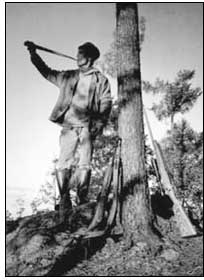 By now it mid-July and my departure date for Siberia had been set for September 12. Time was becoming a critical factor, for by then I had to furnish Paul with the make, serial number and caliber of the rifle I planned to bring into Russia so that a permit could be issued. In other words, there was no turning back now; this rifle had to be finished and shoot satisfactorily ’cause it would be too late to apply for another permit!
By now it mid-July and my departure date for Siberia had been set for September 12. Time was becoming a critical factor, for by then I had to furnish Paul with the make, serial number and caliber of the rifle I planned to bring into Russia so that a permit could be issued. In other words, there was no turning back now; this rifle had to be finished and shoot satisfactorily ’cause it would be too late to apply for another permit!
Right, who says there’s no innovation in Russia? Sundra’s gide, Sergei, fashioned a maral stag bugle out of a roll of 35mm film. The rugged Russia rifle waits against the tree, right, along with Sergei’s scoped SKS.
August 14th my rifle arrived, beautifully done in a densely colored black laminate. This was the first personal rifle of mine that I did not glass bed myself, but it had been done exactly to my specs by Fred (I had sent him my glass-bedded Ruger stock as a model), so I had no reason to doubt that it wasn’t done right. It sure looked like a perfect job.
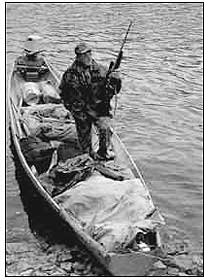 Right, when inclement weather forced a changed of camp, Jon kept his Russia rifle close at hand in the boat. The flat-shooting 7mm JRS would have been great for taking game across Neva river – had any game been sighted.
Right, when inclement weather forced a changed of camp, Jon kept his Russia rifle close at hand in the boat. The flat-shooting 7mm JRS would have been great for taking game across Neva river – had any game been sighted.
There was no less than three weeks to go and I had not yet fire-formed my first case, let alone fired a “real” 7mm JRS load. Which brought up another problem, albeit one of my own making. In my Ruger 7mm JRS I had been using my Winchester’s nickel-plated .280 Rem. Brass because it held more than Remington’s and Norma brass – which is the most voluminous – was not available at the time. Hey, when you’re building a wildcat on what is basically a .30-06 case, every last cubic millimeter of capacity is important!
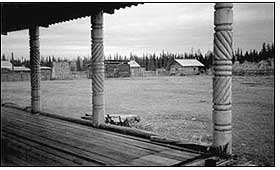 Left, a rare view of a Siberian hunting camp with carved pillars and hand-made buildings. This area of the former Soviet Union was recently opened to Western sportsmen.
Left, a rare view of a Siberian hunting camp with carved pillars and hand-made buildings. This area of the former Soviet Union was recently opened to Western sportsmen.
For several years, Norma .280 Rem. Brass had not been readily available here, but last year it reappeared through Norma’s newest importer, The Paul Co. of Wellsville, Kan., which also imports the Sauer rifle. So rather than develop loads using the ready supply of Winchester and Remington cases I had on hand. I decided to wait for the 100 Norma hulls I ordered.
While waiting for the brass to arrive, I mounted a matte-finished 6×42 Leupold scope in Leupold’s QD mounts. Not that I anticipated any reason for quick scope removal (there are no iron sights on the rifle), I just like the was both rings share the recoil equally compared to the Redfield-type system.
As it turned out, the brass was enroute for more than a week and arrived just five days before my departure. Luckily, having developed loads myself for three other rifles, plus lots of additional data sent me to me by dozens of 7mm JRS owners, I had a wealth of information to work with.
Based on my own experiences and the consensus of others, Reloader 22 was the most outstanding powder. That was no surprise, however, because when it was available in the early years. Norma MRP was what I used almost exclusively and they are about as similar as two powders can be.
I won’t relate the stratospheric velocities some 7mm JRS owners have reported or the handloads used to achieve them, but I will say that in rifles of proper throating and magazine length, 3.050 to 3.100 fps with a 150-grain bullet is the norm.
Over those last few hectic days of fire-forming and load development, my new rifle proved to have at least as good a digestive tract as my three previous ones and proved more accurate than any of them.
Tundra Loads
In a short time I arrived tat two excellent working loads: 64.5 grains of Re 22 behind a 154 gr. Hornady bullet for 3.045 fps, and 65.5 grains of Re pushing a 150 gr. Nosler Partition at 3.095. Both were sparked by a CCI 250 Magnum primer. The former averaged just over 1 1/8″, the latter about 1″ even.
September 12th, I, along with Paul Merzig and two other hunting clients of his, were off to the Lake Baikal region of Siberia. By then our plans had changed somewhat. The ibex was out and the hunt had become one primarily for maral stag (a critter that could virtually pass for a Rocky Mountain elk), for roebuck, and for a bizarre-looking musk deer. he latter is a small, forest-dwelling deer; the males are noted for having 3″long incisors projecting down from their upper jaw. Compared to the fangs on this little deer, Dracula’s condition is a mild case of overbite.
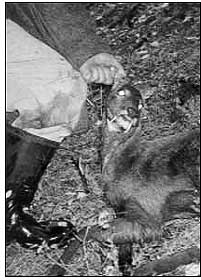 Right, one of the strangest game animals in Siberia is the musk deer, with 3″ fangs in its upper jaw. This one, taken by Gary Holst, was shot on the last day of the hunt with the Russia rifle.
Right, one of the strangest game animals in Siberia is the musk deer, with 3″ fangs in its upper jaw. This one, taken by Gary Holst, was shot on the last day of the hunt with the Russia rifle.
Timing-wise this trip should have been perfect – smack in the middle of the rut which, in that part of the world, normally begins by the first week of September. However, even centuries-old weather patterns shatter when Sundra visits
The day we arrived in Irkutsk, the capital of Siberia, it was 80 degrees, and it was 75-80 degrees every day for the next eight days. Any physical activity, let alone something as strenuous as sex, had to be the furthest thing from the minds of whatever stags were in our hunting area.
It was also obvious that the kind of open-terrain hunting I had envisioned and around which I built my rifle, didn’t exist here. The terrain was steep and densely forested with a mixture of conifers and aspen. If you didn’t know where you were, you’d swear it was Colorado or Wyoming, If the rut started and we were able to call in any amorous stags, shots would average well under 100 yards.
After three days of zero activity, we packed up and moved to another camp some 300 miles north in the hopes of finding cooler weather and the possibility of the rut beginning earlier. To maximize our chances our group split up. Paul and one client were taken to one area, while I and the other client, Gary Holst of Merrill, Iowa, went to another. This time Gary and I even had horses at our disposal, but still the unseasonably warm weather kept game activity at zero.
Finally, on the afternoon of the second to last day of the hunt, three significant things happened: a cold front moved in, I sprained my knee coming down a steep slope, and Gary’s horse panicked when it mis-stepped and too off at full gallop through the forest. Having no such luxury as a saddle scabbard, Gary’s rifle had simply been slung over his shoulder. By the time he got his horse under control, his rifle had bounced off a couple of trees.
The scope’s power ring wouldn’t even move so it was obvious Gary’s rifle was no longer in zero. Since I couldn’t get around well enough to hunt that last day, the solution was obvious: Gary would use my rifle.
By dawn the next morning it was cold enough to actually be snowing a little, boding well for my partner’s last ditch-effort. Gary didn’t return to camp ’til nearly midnight, but when he did it was with one helluva long-fanged musk deer and a beautiful 6×6 stag. As good luck would have it, the musk deer had literally walked into Gary and his guide, Andre, as they were trying to bugle up a stag. By evening the stags were starting to answer Andre’s challenges and just before dark the only stag either of us had seen the entire trip showed himself. One shot through the brisket and the 150 gr. Nosler put him down literally where he stood.
More pictures of the trip:
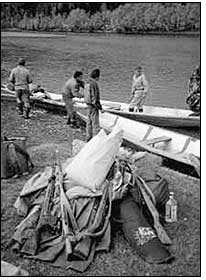 |
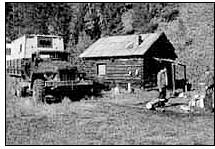 |
For more information contact:
| Black Start Accurizing 11609 Galayda St. Houston, TX 77086 |
The Paul Company Box 177A Wellsville, KS 66092 |
| Paul Merzig’s Adventure Safaris 8 S. Michigan Chicago, IL 60603 |
Wenig Custom Gunstocks 103 N. Market Lincoln, MO 65338 |

